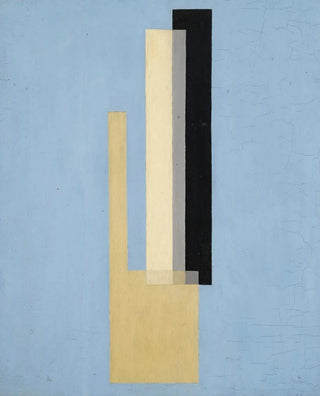Art print | Construction - László Moholy-Nagy


View from behind

Frame (optional)
Construction Art print - László Moholy-Nagy – Captivating introduction
The artwork "Construction" by László Moholy-Nagy presents itself as a bold exploration of shapes and materials, capturing the very essence of the Bauhaus movement. This iconic piece, which merges design and art, evokes a visual dynamism that transcends the simple frame of the canvas. By immersing in this universe, the viewer is invited to discover a world where light and shadow intertwine, revealing unforeseen dimensions. The art print Construction - László Moholy-Nagy allows us to perceive this work from a new perspective, offering a window into the innovative concepts that marked its era.
Style and uniqueness of the work
Moholy-Nagy's style is inseparable from his avant-garde approach. "Construction" stands out through the use of simple yet powerful geometric shapes that seem to float on the surface. This layering technique creates an illusion of depth and movement, bringing to life elements that initially appear static. The chosen colors, often vivid and contrasting, enhance this sense of dynamism and modernity. The artist skillfully plays with lines and angles, transforming the canvas into a space of dialogue between abstraction and reality. Every detail, every aesthetic choice, reflects a deep reflection on the relationship between art and technology, a theme dear to Moholy-Nagy.
The artist and his influence
László Moholy-Nagy, an emblematic figure of the Bauhaus, managed to leave his mark on his era with a bold vision of art. Born in Hungary, he quickly embraced modernist ideas that would redefine artistic practices of the 20th century. His work goes far beyond painting, encompassing photography, design, and even cinema, demonstrating his desire to break traditional boundaries of art. Moholy-Nagy always sought to integrate new technologies into his creative process, convinced that art must evolve with its time. His influence is still felt today, both in the art world and in design, where his ideas continue to inspire contemporary reflections on form, function, and aesthetics.

Matte finish

View from behind

Frame (optional)
Construction Art print - László Moholy-Nagy – Captivating introduction
The artwork "Construction" by László Moholy-Nagy presents itself as a bold exploration of shapes and materials, capturing the very essence of the Bauhaus movement. This iconic piece, which merges design and art, evokes a visual dynamism that transcends the simple frame of the canvas. By immersing in this universe, the viewer is invited to discover a world where light and shadow intertwine, revealing unforeseen dimensions. The art print Construction - László Moholy-Nagy allows us to perceive this work from a new perspective, offering a window into the innovative concepts that marked its era.
Style and uniqueness of the work
Moholy-Nagy's style is inseparable from his avant-garde approach. "Construction" stands out through the use of simple yet powerful geometric shapes that seem to float on the surface. This layering technique creates an illusion of depth and movement, bringing to life elements that initially appear static. The chosen colors, often vivid and contrasting, enhance this sense of dynamism and modernity. The artist skillfully plays with lines and angles, transforming the canvas into a space of dialogue between abstraction and reality. Every detail, every aesthetic choice, reflects a deep reflection on the relationship between art and technology, a theme dear to Moholy-Nagy.
The artist and his influence
László Moholy-Nagy, an emblematic figure of the Bauhaus, managed to leave his mark on his era with a bold vision of art. Born in Hungary, he quickly embraced modernist ideas that would redefine artistic practices of the 20th century. His work goes far beyond painting, encompassing photography, design, and even cinema, demonstrating his desire to break traditional boundaries of art. Moholy-Nagy always sought to integrate new technologies into his creative process, convinced that art must evolve with its time. His influence is still felt today, both in the art world and in design, where his ideas continue to inspire contemporary reflections on form, function, and aesthetics.






